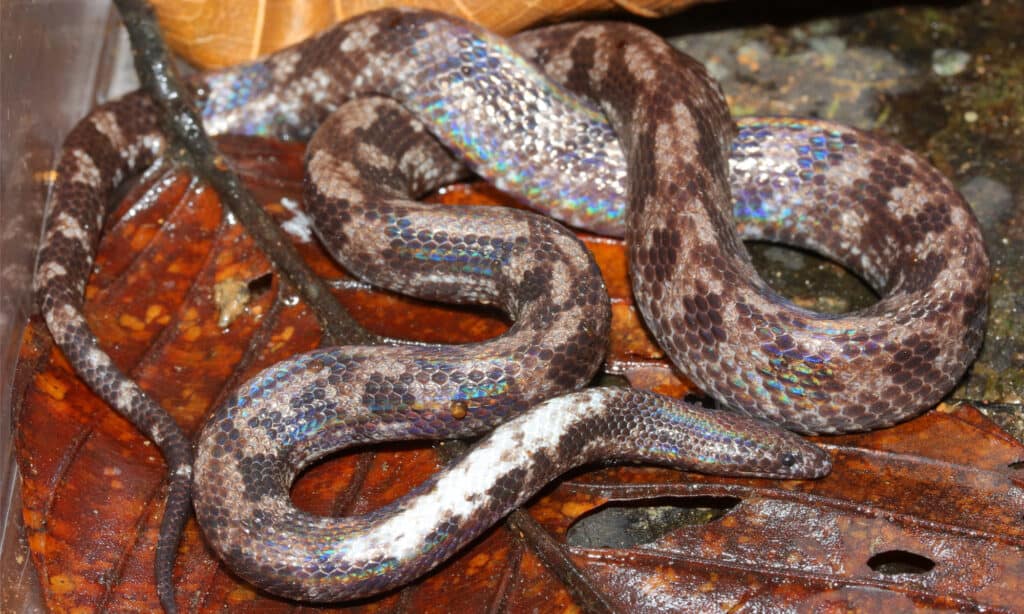Sunbeam Snake
.jumbotron {
background-image: url(“https://a-z-animals.com/media/2022/05/sunbeam-snake-xenopeltis-unicolor-picture-id502621065-400×300.jpg”);
}
}
@media only screen and (min-width: 641px) and (max-width: 920px) {
.jumbotron {
background-image: url(“https://a-z-animals.com/media/2022/05/sunbeam-snake-xenopeltis-unicolor-picture-id502621065-470×370.jpg”);
}
}
@media only screen and (min-width: 921px) {
.jumbotron {
background-image: url(“https://a-z-animals.com/media/2022/05/sunbeam-snake-xenopeltis-unicolor-picture-id502621065.jpg”);
}
}
Sunbeam Snake
Xenopeltis unicolor
Sunbeam snakes have two lungs instead of just a single lung like most snake species.
Sunbeam Snake Scientific Classification
- Kingdom
- Animalia
- Phylum
- Chordata
- Class
- Reptilia
- Order
- Squamata
- Family
- Xenopeltidae
- Genus
- Xenopeltiis
- Scientific Name
- Xenopeltis unicolor
Read our Complete Guide to Classification of Animals.
Sunbeam Snake Conservation Status
Sunbeam Snake Facts
- Favorite Food
- Small birds, reptiles, amphibians and mammals
- Common Name
- Sunbeam snake, common sunbeam snake, iridescent earth snake
- Number Of Species
- 2
Sunbeam Snake Physical Characteristics
- Venomous
- No
- Aggression
- Low
This post may contain affiliate links to our partners like Chewy, Amazon, and others. Purchasing through these helps us further the A-Z Animals mission to educate about the world’s species..

Discover alligator-eating snakes, spiders larger than your phone, and 1000 more incredible animals in our daily FREE email.
.photo-gallery {
–margin: 0px auto 0px;
–padding: 0px 0px 0px 0px;
}
.gallery-link {
background-image: url(“https://a-z-animals.com/media/2022/05/sunbeam-snake-xenopeltis-unicolor-picture-id502621065-1024×614.jpg”);
background-repeat: no-repeat;
background-size: cover;
background-position: center;
height: 500px;
justify-content: center;
text-align: center;
align-items: center;
display: flex;
border: 2px solid #000;
}
.gallery-link img {
height: 50%;
}
@media only screen and (max-width: 768px) {
.gallery-link {
height: 300px !important;
}
}
View all of the Sunbeam Snake images!
The Sunbeam snake is one of two species of iridescent-scaled, non-venomous, nocturnal snake found in Southeast Asia.
Their scales in the shade can look brown, pink, or purplish, but in the light, the dark gray, black, or brown scales flash with intense, metallic color. They are occasionally kept as pets because they are relatively docile and require only a small tank size. Sunbeam snakes are one of the oldest living reptile species and have a skeletal structure that differs significantly from newer species.
Sunbeam Snake Amazing Facts
- Sunbeam snakes are nocturnal.
- Unlike most other snakes, sunbeam snakes enjoy the damp.
- Sunbeam snakes have two lungs instead of just a single lung like most snake species.
- Sunbeam snakes like to burrow in the mud.
- An albino sunbeam snake appears pink instead of black.
- Sunbeam snakes are a type of constrictor, meaning they kill their prey by squeezing it.
Where To Find Sunbeam Snake
The sunbeam snake is endemic to Southeast Asia and Indonesia . Its cousin xenopeltis hainanensis is found in China and Vietnam . They enjoy moist terrain with lots of damp vegetation and mud in which to burrow until nightfall, so they can often be found burrowing in the muck or under leaves. They are found in forests and lower mountain forests with damp ground vegetation, swampy scrublands, rice paddies, and lowland river valleys.
button.pulse {
transform: scale(1); animation: pulse 2s infinite;
box-shadow: 0 0 0 0 rgba(11, 247, 25, 1);
}
@keyframes pulse {
0% { transform: scale(0.90); box-shadow: 0 0 0 0 rgba(11, 247, 25, 0.5); }
60% { transform: scale(1); box-shadow: 0 0 0 15px rgba(11, 247, 25, 0); }
100% { transform: scale(0.90); box-shadow: 0 0 0 0 rgba(11, 247, 25, 0); }
}
Scientific Name
The sunbeam snake comes from the family xenopeltidae and like all snakes is in the class reptilia. There are two species of sunbeam snake recognized, including the sunbeam snake sometimes known as the iridescent ground snake, and a smaller, less common secondary species, which is typically known as the Hainan sunbeam. The scientific names for the two species of sunbeam snakes are xenopeltis unicolor, which is the more common sunbeam snake discussed here in this article, and xenopeltis hainanensis. There are only a few small differences between them, mainly with regard to body length and tail size. Xenopeltis is a Greek word meaning small shield, while unicolor means “of one color” in English.
Population & Conservation Status
The sunbeam snake is listed as being of Least Concern (LC) by the ICUN Red list. They are capable of laying between three and 18 eggs at a time, and their habitat is plentiful for now. Since they like to burrow and only come out at night to hunt encounters with humans in the wild are lower than many snakes and they have few natural predators. As of their last assessment back in 2012, their population was listed as stable. Their prevalence is listed as “very common.”
Appearance & Description
An adult sunbeam snake is approximately three to three and a half feet in length. They are slender and weigh around two and a quarter pounds when fully grown. Their scales are a dark and shiny gunmetal gray, black, or dark brown, with an iridescent holographic finish. In the shadows, the snakes may appear dark pink or purple. When light hits the scales of a sunbeam snake, the scales appear to be painted with metallic rainbow halos, similar to the colored surface found on an oily puddle on the pavement, or the colored swirls on a child’s soap bubbles. These rainbow halos may show any color of the rainbow, though purple and orange may be harder to pick out. Their eyes are small in size compared to their wedge-shaped head and are black or gray in color. Albino sunbeam snakes may be pink or white.

iStock.com/Zdenek Macat
Sunbeam Snake: How Dangerous Are They?
Sunbeam snakes are not venomous and therefore, they pose virtually no threat to humans whatsoever. The two species of sunbeam snake are rarely if ever aggressive, except in very specific circumstances when they feel threatened. Sunbeam snakes almost never bite humans, except in the aforementioned situations, such as rough or excessive handling or when accidentally stepped on. These snakes kill their prey by constriction, though they will use their bite to catch it. If these snakes do bite, there is no venom, but a sunbeam snake bite should be treated like any other puncture wound, to protect against infection. Consult a physician if you are bitten, just in case a tetanus shot is warranted.
Sunbeam Snake Behavior and Humans
Sunbeam snakes are not venomous and are very docile. These things combined with their beauty make them popular pets. However, their intolerance of more than occasional, careful handling and preference for a live diet makes them harder to maintain as pets for inexperienced snake owners, so they are not a pet for beginners or young children. Sunbeam snakes aren’t very large, only three feet long or so, so their enclosure doesn’t need to be very large either. Having a tank size of about 40 gallons is usually sufficient for up to two sunbeam snakes. The price for a pet sunbeam snake is also reasonable, at around $70 to $100. A pet sunbeam snake that is cared for well can have a lifespan as long as 10 years or more.
View all 186 animals that start with S
Sunbeam Snake FAQs (Frequently Asked Questions)
Can you have a sunbeam snake as a pet?
Yes, a sunbeam snake can be kept as a pet, though prior snake experience is recommended.
What tank size does a sunbeam snake need?
A 40-gallon tank is usually a large enough enclosure for a sunbeam snake.
Is a sunbeam snake poisonous?
Sunbeam snakes are a type of non-venomous snake, so their bite is not dangerous.
Are sunbeam snakes good for beginners?
Though they are docile and small in size, sunbeam snakes are not a particularly good breed for beginners, as they are prone to stress when handled and require live prey for their diet.
Do sunbeam snakes like to be held?
Sunbeam snakes are fairly docile and may not mind being held occasionally, but they may dislike being handled often or for long and emit a musky odor if it stresses them out.
How much does a sunbeam snake cost?
Typically, you may purchase a sunbeam snake for a price between $75 – 100. An albino may have a different price.
Sources
- Everything Reptiles Sunbeam Snake, Available here: https://www.everythingreptiles.com/sunbeam-snake/
- Wikipedia, Available here: https://en.wikipedia.org/wiki/Xenopeltis
- Ecology Asia, Available here: https://www.ecologyasia.com/verts/snakes/sunbeam_snake.htm
- Thai National Parks, Available here: https://www.thainationalparks.com/species/xenopeltis-unicolor
- Reptile Direct, Available here: https://www.reptiledirect.com/sunbeam-snake/
- Outback Reptiles, Available here: https://www.outbackreptiles.com/2018/03/sunbeam-snake-care-how-to-keep-sunbeam-snakes/
- Reptile Guide, Available here: https://reptile.guide/sunbeam-snake-care/
- Happy Serpent, Available here: https://happyserpent.com/snake-profile/sunbeam-snake/
- Britannica, Available here: https://www.britannica.com/animal/sunbeam-snake
- Encyclopedia.com, Available here: https://www.encyclopedia.com/science/encyclopedias-almanacs-transcripts-and-maps/sunbeam-snakes-xenopeltidae
- Animals J Rank, Available here: https://animals.jrank.org/pages/3820/Sunbeam-Snakes-Xenopeltidae-PHYSICAL-CHARACTERISTICS.html
- Nature Nibble, Available here: https://naturenibble.com/types-of-sunbeam-snakes/
- Reptiles Magazine, Available here: https://reptilesmagazine.com/listings/snake-care/sunbeam-snake/
















